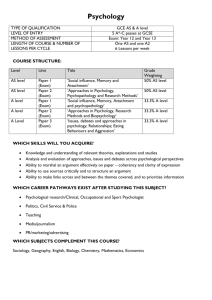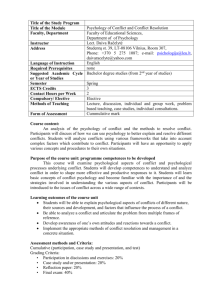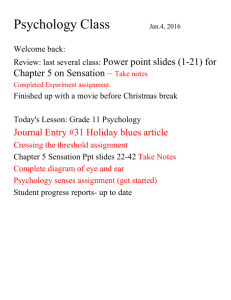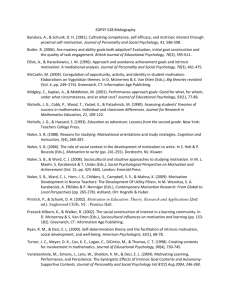MOR 601 Seminar in Organizational Behavior
advertisement
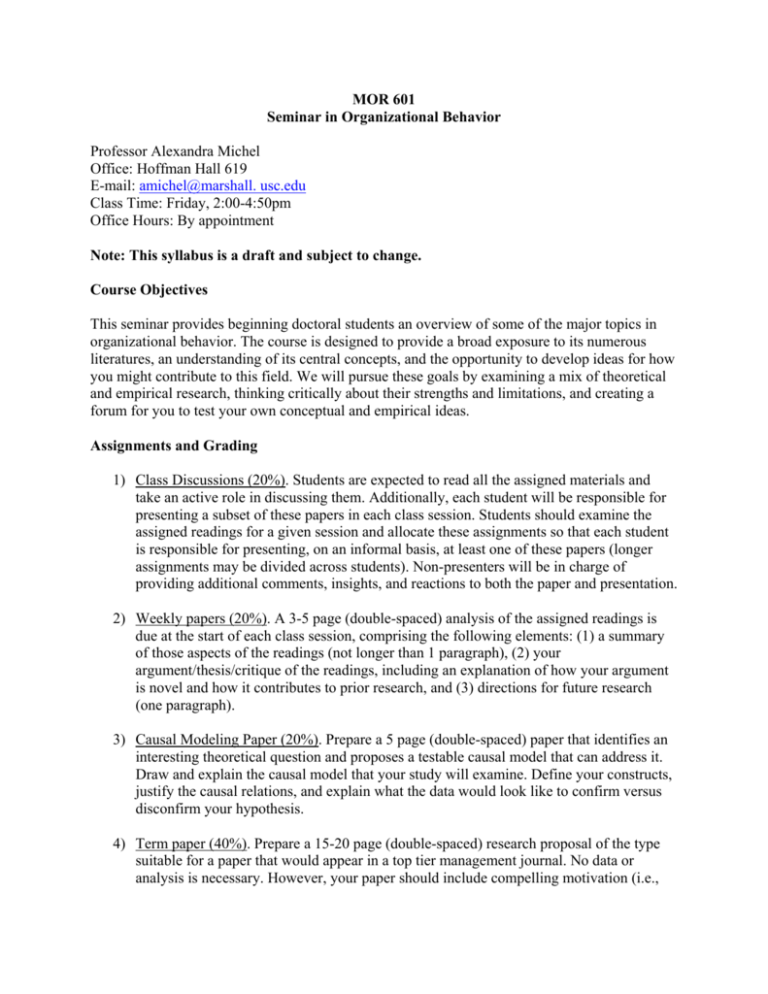
MOR 601 Seminar in Organizational Behavior Professor Alexandra Michel Office: Hoffman Hall 619 E-mail: amichel@marshall. usc.edu Class Time: Friday, 2:00-4:50pm Office Hours: By appointment Note: This syllabus is a draft and subject to change. Course Objectives This seminar provides beginning doctoral students an overview of some of the major topics in organizational behavior. The course is designed to provide a broad exposure to its numerous literatures, an understanding of its central concepts, and the opportunity to develop ideas for how you might contribute to this field. We will pursue these goals by examining a mix of theoretical and empirical research, thinking critically about their strengths and limitations, and creating a forum for you to test your own conceptual and empirical ideas. Assignments and Grading 1) Class Discussions (20%). Students are expected to read all the assigned materials and take an active role in discussing them. Additionally, each student will be responsible for presenting a subset of these papers in each class session. Students should examine the assigned readings for a given session and allocate these assignments so that each student is responsible for presenting, on an informal basis, at least one of these papers (longer assignments may be divided across students). Non-presenters will be in charge of providing additional comments, insights, and reactions to both the paper and presentation. 2) Weekly papers (20%). A 3-5 page (double-spaced) analysis of the assigned readings is due at the start of each class session, comprising the following elements: (1) a summary of those aspects of the readings (not longer than 1 paragraph), (2) your argument/thesis/critique of the readings, including an explanation of how your argument is novel and how it contributes to prior research, and (3) directions for future research (one paragraph). 3) Causal Modeling Paper (20%). Prepare a 5 page (double-spaced) paper that identifies an interesting theoretical question and proposes a testable causal model that can address it. Draw and explain the causal model that your study will examine. Define your constructs, justify the causal relations, and explain what the data would look like to confirm versus disconfirm your hypothesis. 4) Term paper (40%). Prepare a 15-20 page (double-spaced) research proposal of the type suitable for a paper that would appear in a top tier management journal. No data or analysis is necessary. However, your paper should include compelling motivation (i.e., why is this project interesting), relevant theory (including research that may not have been assigned for the class), testable hypotheses, an explicit research design, and a discussion of the expected results. Students should develop this proposal with the expectation that it will become a publishable paper. Reading List Week 1 (Aug. 29): Introduction - Barley, S.R. (2006). When I write my masterpiece: Thoughts on what makes a paper interesting. Academy of Management Journal, 49(1): 16-20. - Bartunek, J.M., S.L. Rynes, and R. D. Ireland (2006). What makes management research interesting and why does it matter? Academy of Management Journal, 49(1): 9-16. - Whetten, D.A. (1989). What constitutes a theoretical contribution? Academy of Management Review, 14(4), 490-495. - Ross, L., and Nisbett, R. (1991). The Person and the Situation. New York: McGrawHill, Inc., Chapter 8. - Sutton, R.I. and Staw, B.M. (1995). What theory is not. Administrative Science Quarterly, 40(3), 371-384. - Weick, K.E. (1989). Theory construction as disciplined imagination. The Academy of Management Review, 14(4), 516-531. Week 2 (Sept. 5): Person vs. Situation - Mischel, W. and Y. Shoda (1995). A cognitive-affective system theory of personality: Reconceptualizing situations, dispositions, dynamics, and invariance in personality structure. Psychological Review, 102: 246-268. - Davis-Blake, A., & Pfeffer, J. (1989). Just a mirage: The search for dispositional effects in organizational research. Academy of Management Review, 14, 385-400. - Higgins, E. T. (1990). Personality, social psychology, and person-situation relations: Standards and knowledge activation as a common language. In L. A. Pervin (Ed.), Handbook of personality: Theory and research (pp. 301-338). New York, NY: The Guilford Press. - House, R.J., Shane, S.A., Herold, D.M. (1996). Rumors of the death of dispositional research are vastly exaggerated. Academy of Management Review, 21(1), 203-224. - Lave, J. (1996). The practice of learning. In Chaiklin, S. and J. Lave (eds.), Understanding practice: Perspectives on activity and context, (pp. 3-35). New York: Cambridge University Press. Week 3 (Sept. 12): The Self - Baumeister, R.F. (1999). The nature and structure of the self: An overview. In R.F. Baumeister (ed.), The self in social psychology, (pp. 1-20). Philadelphia, PA: Taylor and Francis. - Carver, C. and M. Scheier (1982). Control theory: A useful conceptual framework for personality-social, clinical, and health psychology. Psychological Bulletin, 92: 111135. - Higgins, E.T. (1996a). The “Self Digest”: Self-knowledge serving self-regulatory functions. Journal of Personality and Social Psychology, 71(6), 1062-1083. - - Chen, S., H.C. Boucher, and M. Parker Tapias (2006). The relational self revisited: Integrative conceptualizations and implications for interpersonal life. Psychological Bulletin, 132(2): 151-179. Markus, H. and E. Wurf (1987). The dynamic self-concept: A social psychological perspective. Annual Review in Psychology, 38: 299-337. Week 4: (Sept. 19): Motivation and Job Design - Higgins, E.T. and A.W. Kruglanski: Motivational science: The nature and functions of wanting. In E.T. Higgins and A.W. Kruglanski (eds.) Motivational Science: Social and Personality Perspectives: 1-20, Philadelphia, PA: Taylor and Francis. - Heine, S.J. (2007). Culture and motivation. What motivates people to act in the ways that they do? In S. Kitayama and D. Cohen (eds.), Handbook of Cultural Psychology: 714-734. New York: Guilford. - Dweck, C.S. and E. L. Leggett (1988). A social-cognitive approach to motivation and personality. Psychological Review, 95: 256-273. - Higgins, E.T. (1997). Beyond pleasure and pain. American Psychologist, 52: 12801300. - Ellemers, N., D. De Gilder, and S.A. Haslam (2004). Motivating individuals and groups at work: A social identity perspective on leadership and group performance. Academy of Management Review, 29(3), 459-478. Week 5 (Sept. 26): Cognition - Berkowitz, L. and P. Devine (1995). Has social psychology always been cognitive? What is “cognitive’ anyhow? Personality and Social Psychology Bulletin, 21(7): 696703. - Aronson, E. (2004). The social animal. Chapter 4: Social cognition. New York: Worth. - Walsh, J.P. (1995). Managerial and organizational cognition: Notes from a trip down memory lane. Organization Science, 6(3), 280-321. - Prawat, R.S. (1996). Constructivisms, modern and postmodern. Educational Psychologist: 31(3/4): 215-225. - Levine, J.M., L.B. Resnick, and T.E. Higgins (1993). Social foundations of cognition. Annual Review of Psychology, 44: 585-612. - Weick, K. E. (1998). Improvisation as a mindset for organizational analysis. Organization Science, 9: 543-555. Week 6 (Oct. 3): Emotions - Kemper, T. D. (1993). Sociological models in the explanation of emotions. In M. Lewis & J. M. Haviland (Eds.), Handbook of Emotion. New York: Guilford. - Markus, H.R. and S. Kitayama (1994). The cultural construction of self and emotion: Implications for social behavior. In S. Kitayama and H.R. Markus (eds.), Emotion and culture: Empirical studies of mutual influence (pp. 89-130). Washington, DC: American Psychological Association. - - - Keltner, D. and J. Haidt (2001). Social function of emotions at four levels of analysis. In W.G. Parrott (ed.) Emotions in Social Psychology. Key Readings in Social Psychology (pp. 175-185). Taylor and Francis: Philadelphia, PA. Lutz, C. and G.M. White (1986). The anthropology of emotions. Annual Review of Anthropology, 15: 405-436. Gergen, K.J. (1994). Emotion as relationship. In K.J. Gergen: Realities and Relationships. Soundings in social construction: 210-235. Cambridge, MA: Harvard University Press. Lazarus, R.S. (1991). Cognition and motivation in emotion. American Psychologist, 46(4), 352-367. Zajonc, R.B. (1980). Feeling and thinking: Preferences need no inferences. American Psychologist, 35: 151-175. Week 7 (Oct. 10): Decision Making - Staw, B.M. (1976). Knee deep in the big muddy: A study of escalating commitment to a chosen course of action. Organizational Behavior and Human Decision Performance, 16, 27-44. - Gergen, K.J. (1994). Objectivity as rhetorical achievement. In K.J. Gergen: Realities and Relationships. Soundings in social construction: 165-184. Cambridge, MA: Harvard University Press. - Tversky, A. and D. Kahneman. (1974). Judgment under uncertainty: Heuristics and biases. Science, 185, 1124-1131. - Staw, B.M., L.E. Sandelands, and J.E. Dutton. (1981). Threat rigidity effects in organizational behavior: A multilevel analysis. Administrative Science Quarterly, 26(4), 501-524. - Ajzen, I. (1996). The social psychology of decision making. In E.T. Higgins and A.W. Kruglanski (eds.). Social Psychology: Handbook of Basic Principles: 297-328. New York, NY: The Guilford Press. - Weick, K.E. (1990). The vulnerable system: An analysis of the Tenerife Air Disaster. Journal of Management, 16(3): 571-593. Week 8 (Oct. 17): Interpersonal Perceptions - Brewer, M.B., and W. Gardner. (1996). Who is this “We”? Levels of collective identity and self representations. Journal of Personality and Social Psychology, 71(1), 83-93. - Tajfel, H. and J. Turner. (1979). An integrative theory of intergroup conflict. In W. G. Austin and S. Worchel (eds.), The social psychology of intergroup relations: 33-47. Monterey, CA: Brooks and Cole. - Bourdieu, P. (1980). The Logic of Practice. Book 1, Chapter 3: Structures, habitus, practices (p. 52-66) and Chapter 4: Belief and the body (p. 66). Stanford, CA: Stanford University Press. - Weick, K.E., K.M. Sutcliffe, and D. Obstfeld. (2005). Organizing and the process of sensemaking. Organization Science, 16(4): 409-421. Week 9 (Oct. 24): Power and Influence - Emerson, R.M. (1962). Power-Dependence Relations. American Sociological Review, 27(1), 31-41. - Dreyfus, H.L. and P. Rabinow. (1983). Power and truth. In Michel Foucault: Beyond Structuralism and Hermeneutics (2nd edition): 184-204. Chicago, Ill: University of Chicago Press. - Bourdieu, P. (1980). The Logic of Practice. Book 1, Chapter 8: Modes of domination (pp. 122-134). Stanford, CA: Stanford University Press. - Aronson, E. (2004). The social animal. Chapter 3: Mass communication, propaganda, and persuasion. New York: Worth. - Cialdini, R.B. and M.R. Trost. (1998). Social influence: Social norms, conformity, and compliance. In Gilbert, D.T., S.T. Fiske, and G. Lindzey (eds.), The Handbook of Social Psychology, Volume 2: 151-192. New York, NY: McGraw Hill. - Molm, L.D. (1989). Punishment power: A balancing process in power-dependence relations. American Journal of Sociology, 94(6), 1392-1418. Week 10 (Oct. 31): Socialization and Learning - Nicolini, D., S. Gherardi, and D. Yanow (2003). Introduction: Toward a practicebased view of knowing and learning in organizations. In D. Nicolini, S. Gherardi, and D. Yanow (eds.), Knowing in organizations: A practice-based approach; 3-31. London, UK: Sharpe. - Van Maanen, J. and E.H. Schein (1979). Towards a theory of organizational socialization. In B.M. Staw (ed.), Research in organizational behavior (Vol. 1, pp. 209-264). Greenwich, CT: JAI Press. - Lave, J. (1991). Situating learning in communities of practice. In L.B. Resnick, J.M. Levine, and S.D. Teasley (eds.), Perspectives on Socially Shared Cognition: 63-84. Washington, DC: American Psychological Association. - Barab, S.A., and J.A. Plucker (2002). Smart people or smart contexts? Cognition, ability, and talent development in an age of situated approaches to knowing and learning. Educational Psychologist, 37(3): 165-182. - Sfard, A. (1998). On two metaphors of learning and the dangers of choosing just one. Educational Researcher, 27(2), 4-13. Week 11 (Nov. 7): Group Relations - Levine, J. M. and R.L. Moreland (1998). Small groups. In Gilbert, D.T., S.T. Fiske, and G. Lindzey (eds.), The Handbook of Social Psychology, Volume 2: 415-469. New York, NY: McGraw Hill. - Ancona, D.G. & Caldwell, D.F. (1992). Bridging the boundary: External activity and performance in self-regulating work groups. Administrative Science Quarterly, 37(4), 634-665. - Kruglanski, A., A. Pierro, L., L. Mannetti, and E. deGrada (2006). Groups as epistemic providers: Need for closure and the unfolding of group-centrism. Psychological Review, 113(1): 84-100. - Barker, J.R. (1993). Tightening the iron cage: Concertive control in self-managing teams. Administrative Science Quarterly, 38(3), 408-437. Klein, K.J., J.C. Ziegert, A.P. Knight, and Y. Xiao (2006). Dynamic delegation: shared hierarchical, and deindividualized leadership in extreme action teams. Administrative Science Quarterly, 51(4): 590-621. *** Causal Model Paper Due *** Week 12 (Nov. 14): Collective Cognition - Latour, B. (2007). On the difficulty of being an ANT: An interlude in the form of a dialog. In B. Latour: Reassembling the social: An introduction to Actor-NetworkTheory: 141-156. New York: Oxford. - Wegner, D.M. (1986). Transactive memory: A contemporary analysis of the group mind. In B. Mullen & G.R. Goethals (Eds.) Theories of group behavior. New York, NY: Springer Verlag. - Weick, K.E., and K.H. Roberts (1993). Collective mind in organizations: Heedful interrelating on flight decks.” Administrative Science Quarterly, 38: 357-381. - Wertsch, J. (1998). Mind as action: pp. 3-72. New York: Oxford. - Brown, J., and P. Duguid (1991). Organizational learning and communities-ofpractice: Towards a unified view of working, learning, and innovation. Organization Science, 2(1), 40-57. Week 13 (Nov. 21): Culture - Norenzayan, A. and S.J. Heine (2005). Psychological universals: What are they and how can we know? Psychological Bulletin: 131(5): 763-784. - Gergen, K.J. (1990). Social understanding and the inscription of self. In J.W. Stigler, R.A. Shweder, and G. Herdt (eds.), Cultural psychology: Essays on comparative human development: 569-607. New York: Cambridge. - Markus, H.R., S. Kitayama, and R.J. Heiman (1996). Culture and basic psychological principles. In E.T. Higgins and A.W. Kruglanski (eds.), Social Psychology: Handbook of Basic Principles, 4: 857-913. New York, NY: Guilford. - Shweder, R. (1990). Cultural psychology – what is it? In J.W. Stigler, R.A. Shweder, and G. Herdt (eds.), Cultural psychology: Essays on comparative human development. New York: Cambridge. - O’Reilly, C. and J.A. Chatman (1996). Culture as social control: Corporations, cults, and commitment. In B. M. Staw and L. L. Cummings (eds), Research in Organizational Behavior, 18: 157-200. Greenwich, CT: JAI Press. Thanksgiving (Nov. 28) Æ No Class Week 14 (Dec. 5): Review and Integration - We will discuss the structure of this session in class. *** Term Paper Due: Dec. 5 ***

